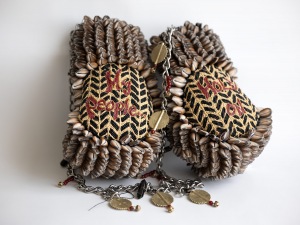Janyce Denise Glasper’s trip to Miami’s Art Basel and the allied fairs, Untitled and Prizm was lightning fast and filled with eye treats. Janyce highlights examples of diversity in the fairs, which historically have been criticized for their lack of inclusion. Enjoy this roundup of names and images of artists you may or may not be familiar with.
I kept gasping in awe at the enthralling spectacles that Art Basel, Prizm, and untitled provided, hoping that prominent curators and collectors wanted to represent these fresh talents for longer than a single weekend. I witnessed more diversity on Miami walls and pedestals than I had seen all year, a woman who traveled to four countries searching for it.
My second day in Miami focused on the Prizm and untitled art fairs. I attended both events with my Canada-based friend Glodeane Brown, arts advocate and blogger at Culture Fancier.
Untitled art fair
Down to the beach, we ventured, for the chaotically busy untitled art fair— a red tented experience close to the crystal blue shore featuring almost two-hundred galleries, artist-run spaces, and non-profit organizations from thirty-eight countries. Unfortunately, we had thirty minutes to wander through the maze of booths set up similarly to Art Basel. They were closing at five PM. The others ended at six PM.
Patricia Sweetow— a Los Angeles based gallery— featured an inclusive array of artists. The weight of the metaphor is heavy and strong in Demetri Broxton’s “Hold On,” earth-toned mixed media boxing gloves, employ fascinating materials— hand cut Monetaria caputserpentis (aka serpent’s head) cowrie shells, glass beads, tourmaline points, brass Baule pendants, etc. They hang on the wall, the “Hold On” glove resting on its “My People” twin, the red beaded text activating against intricate yellow and black zigzags. While Broxton’s title may be a play on Eddie Kendrick’s hymnic chant song, “My People… Hold On,” why not include Teddy Pendergrass’s “TKO,” a romantic slow jam comparing love to a “technical knockout?” These gloves symbolize sacred entities not built for a traditional sparring match, primarily inherent in the specificity of the precious materials fusing the artist’s Black and Asian heritage. Pendergrass wants to let it go and search for new love, entailing that through the face of great heartbreak, the fight wages onward. Broxton, however, wants us to stay in love sans our fists, to stay in the realm of good possibilities.


